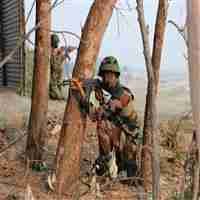Following Chinese forces’ aggressive moves/misadventures against the Indian Army in Eastern Ladakh since May 2020, Pakistani forces stepped up ceasefire violations/unprovoked firing and bombardment/induction of terrorists across both the International Boundary (IB) and the Line of Control (LoC) in Jammu and Kashmir (J & K).
After Indian Army’s surprise moves of August 29-30, 2020 resulting in occupation of commanding positions on the Kailash Ridge/south bank of Pangong Tso, while Chinese have been shocked and frustrated, Pakistani forces went into overdrive targeting India’s civil population in the border belt, particularly so in the days preceding Diwali.
Over a period of at least a week in the run-up to Diwali, there were many incidents of firing small arms and mortar bombs in Uri, Poonch, Gurez, Machil, Dawar, Keran and Naugam sectors, causing deaths of and injuries to many civilians, Army and BSF personnel. Both Army and BSF have been responding fiercely, causing substantial damage to Pakistan military assets, as seen in some videos released by the Army.It is relevant to look back at the pattern of ceasefire violations almost all of which are related to Pakistan’s decades old drive to continue its fourth war against India by export of terrorism.
Pakistan on a ceasefire violation spree
The number of ceasefire violations by Pak troops from January till November 2020, along the J&K border have broken all records of the past 17 years. Till mid-November 2020, the total number of ceasefire violations till date amount to at least 4,052, of which 394 were in October and 128 in just about half November. In 2019, there were 3,233 ceasefire violations by the Pakistan Army along the Indo-Pak border. When the figure of 3800 violations was reached in October, 2020, Ministry of External Affairs spokesperson Anurag Srivastava said, “This is a clear violation of the 2003 ceasefire understanding between the two sides. This year, till date, Pakistani forces have carried out more than 3,800 unprovoked ceasefire violations.”
The number of ceasefire violations by Pak troops from January till November 2020, along the J&K border have broken all records of the past 17 years. Till mid-November 2020, the total number of ceasefire violations till date amount to at least 4,052, of which 394 were in October and 128 in just about half November.
Earlier, in June 2020, the Jammu-based defence spokesperson Lt Col Devender Anand said, “There have been more than 2000 incidents of ceasefire violations along the Line of Control by the Pakistani troops in less than six months in the year 2020.” He added that there were 114 ceasefire violations in the first 10 days of June, 2020, as compared to 181 in entire June 2019 and 14 instances in entire June 2018. He further remarked that the 2020 figure of ceasefire violations was astonishing, because in less than 6 months there were more than 2000 violations. The total violations of a number of years till 2017, were not as many as those in entire 2018.
Time to rethink
The number of ceasefire violations by Pakistani troops in 2019 were over 300 more than in 2018 and over three times that of 2017, when 971 cases were reported. In 2017, 31 people—12 civilians and 19 security forces personnel were killed and 151 others suffered injuries. Despite the ongoing pandemic caused by the Chinese/Wuhan virus and even during the global lockdown, the LoC continued to remain a war zone as there has been no let down in operations in J&K, which led to increased engagements between the troops and terrorists.
Giving details of cases of ceasefire violations in the past decade, according to inputs from government officials in media, 405 cases of ceasefire violations were reported in 2015, and 583 in 2014. From 2009 to 2013, there was a gradual increase in ceasefire violations by Pakistan. The figures for 2013, 2012, 2011, 2010 and 2009 were 347, 114, 62, 44, and 28 respectively.
According to official data, the numbers of ceasefire violations were 77 in 2008, 21 in 2007 and three in 2006. For three years, following the Vajpayee-Musharraf ceasefire agreement in November 2003, ie 2004, 2005 and 2006, there was not a single violation on the border. But that was too much to digest for Pakistan’s Inter-Services Intelligence and its lackeys in the Valley, the separatists-read treacherous tools of terror. The rest—radicalisation, stone-pelting, burning of schools etc—is history, still not taught in India.


